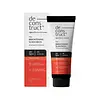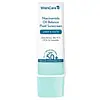What's inside
What's inside
 Key Ingredients
Key Ingredients

 Benefits
Benefits

 Concerns
Concerns

 Ingredients Side-by-side
Ingredients Side-by-side

Water
Skin ConditioningEthylhexyl Methoxycinnamate
UV AbsorberButyl Methoxydibenzoylmethane
UV AbsorberBenzophenone-3
UV AbsorberPEG-100 Stearate
Butylene Glycol
HumectantPhospholipids
Skin ConditioningPhenoxyethanol
PreservativeGlycerin
HumectantEthylhexylglycerin
Skin ConditioningNiacinamide
SmoothingXanthan Gum
EmulsifyingLecithin
EmollientSclerotium Gum
Emulsion StabilisingPullulan
Sodium Acrylates Copolymer
Allantoin
Skin ConditioningDisodium EDTA
Water
Skin ConditioningCyclopentasiloxane
EmollientEthylhexyl Salicylate
UV AbsorberNiacinamide
SmoothingSilica
AbrasiveButyl Methoxydibenzoylmethane
UV AbsorberOctocrylene
UV AbsorberButylene Glycol
HumectantGlycerin
HumectantHomosalate
Skin ConditioningTapioca Starch
Neopentyl Glycol Diheptanoate
EmollientAmps/Hema Crosspolymer
C13-15 Alkane
SolventCoco-Glucoside
CleansingOctyldodecanol
EmollientPolysorbate 20
EmulsifyingZinc Oxide
Cosmetic ColorantTitanium Dioxide
Cosmetic ColorantAvena Sativa Kernel Extract
AbrasiveZinc PCA
HumectantSorbitan Olivate
EmulsifyingCeramide AP
Skin ConditioningCeramide NP
Skin ConditioningCeramide Eos
Skin ConditioningPanthenol
Skin ConditioningCentella Asiatica Extract
CleansingEthylhexylglycerin
Skin ConditioningPhenoxyethanol
PreservativeXanthan Gum
EmulsifyingTocopheryl Acetate
AntioxidantHyaluronic Acid
HumectantCitric Acid
BufferingWater, Cyclopentasiloxane, Ethylhexyl Salicylate, Niacinamide, Silica, Butyl Methoxydibenzoylmethane, Octocrylene, Butylene Glycol, Glycerin, Homosalate, Tapioca Starch, Neopentyl Glycol Diheptanoate, Amps/Hema Crosspolymer, C13-15 Alkane, Coco-Glucoside, Octyldodecanol, Polysorbate 20, Zinc Oxide, Titanium Dioxide, Avena Sativa Kernel Extract, Zinc PCA, Sorbitan Olivate, Ceramide AP, Ceramide NP, Ceramide Eos, Panthenol, Centella Asiatica Extract, Ethylhexylglycerin, Phenoxyethanol, Xanthan Gum, Tocopheryl Acetate, Hyaluronic Acid, Citric Acid
Ingredients Explained
These ingredients are found in both products.
Ingredients higher up in an ingredient list are typically present in a larger amount.
Also known as Avobenzone, this ingredient is a chemical sunscreen filter that provides protection in the UV-A range.
Avobenzone is globally approved and is the most commonly used UV-A filter in the world.
Studies have found that avobenzone becomes ineffective when exposed to UV light (it is not photostable; meaning that it breaks down in sunlight). Because of this, formulations that include avobenzone will usually contain stabilizers such as octocrylene.
However, some modern formulations (looking at you, EU!) are able to stabilize avobenzone by coating the molecules.
Avobenzone does not protect against the UV-B range, so it's important to check that the sunscreen you're using contains other UV filters that do!
The highest concentration of avobenzone permitted is 3% in the US, and 5% in the EU.
Learn more about Butyl MethoxydibenzoylmethaneButylene Glycol (or BG) is used within cosmetic products for a few different reasons:
Overall, Butylene Glycol is a safe and well-rounded ingredient that works well with other ingredients.
Though this ingredient works well with most skin types, some people with sensitive skin may experience a reaction such as allergic rashes, closed comedones, or itchiness.
Learn more about Butylene GlycolEthylhexylglycerin (we can't pronounce this either) is commonly used as a preservative and skin softener. It is derived from glyceryl.
You might see Ethylhexylglycerin often paired with other preservatives such as phenoxyethanol. Ethylhexylglycerin has been found to increase the effectiveness of these other preservatives.
Glycerin is already naturally found in your skin. It helps moisturize and protect your skin.
A study from 2016 found glycerin to be more effective as a humectant than AHAs and hyaluronic acid.
As a humectant, it helps the skin stay hydrated by pulling moisture to your skin. The low molecular weight of glycerin allows it to pull moisture into the deeper layers of your skin.
Hydrated skin improves your skin barrier; Your skin barrier helps protect against irritants and bacteria.
Glycerin has also been found to have antimicrobial and antiviral properties. Due to these properties, glycerin is often used in wound and burn treatments.
In cosmetics, glycerin is usually derived from plants such as soybean or palm. However, it can also be sourced from animals, such as tallow or animal fat.
This ingredient is organic, colorless, odorless, and non-toxic.
Glycerin is the name for this ingredient in American English. British English uses Glycerol/Glycerine.
Learn more about GlycerinNiacinamide is a multitasking form of vitamin B3 that strengthens the skin barrier, reduces pores and dark spots, regulates oil, and improves signs of aging.
And the best part? It's gentle and well-tolerated by most skin types, including sensitive and reactive skin.
You might have heard of "niacin flush", or the reddening of skin that causes itchiness. Niacinamide has not been found to cause this.
In very rare cases, some individuals may not be able to tolerate niacinamide at all or experience an allergic reaction to it.
If you are experiencing flaking, irritation, and dryness with this ingredient, be sure to double check all your products as this ingredient can be found in all categories of skincare.
When incorporating niacinamide into your routine, look out for concentration amounts. Typically, 5% niacinamide provides benefits such as fading dark spots. However, if you have sensitive skin, it is better to begin with a smaller concentration.
When you apply niacinamide to your skin, your body converts it into nicotinamide adenine dinucleotide (NAD). NAD is an essential coenzyme that is already found in your cells as "fuel" and powers countless biological processes.
In your skin, NAD helps repair cell damage, produce new healthy cells, support collagen production, strengthen the skin barrier, and fight environmental stressors (like UV and pollution).
Our natural NAD levels start to decline with age, leading to slower skin repair, visible aging, and a weaker skin barrier. By providing your skin niacinamide, you're recharging your skin's NAD levels. This leads to stronger, healthier, and younger looking skin.
Another name for vitamin B3 is nicotinamide. This vitamin is water-soluble and our bodies don't store it. We obtain Vitamin B3 from either food or skincare. Meat, fish, wheat, yeast, and leafy greens contain vitamin B3.
The type of niacinamide used in skincare is synthetically created.
Learn more about NiacinamidePhenoxyethanol is a preservative that has germicide, antimicrobial, and aromatic properties. Studies show that phenoxyethanol can prevent microbial growth. By itself, it has a scent that is similar to that of a rose.
It's often used in formulations along with Caprylyl Glycol to preserve the shelf life of products.
Water. It's the most common cosmetic ingredient of all. You'll usually see it at the top of ingredient lists, meaning that it makes up the largest part of the product.
So why is it so popular? Water most often acts as a solvent - this means that it helps dissolve other ingredients into the formulation.
You'll also recognize water as that liquid we all need to stay alive. If you see this, drink a glass of water. Stay hydrated!
Learn more about WaterXanthan gum is used as a stabilizer and thickener within cosmetic products. It helps give products a sticky, thick feeling - preventing them from being too runny.
On the technical side of things, xanthan gum is a polysaccharide - a combination consisting of multiple sugar molecules bonded together.
Xanthan gum is a pretty common and great ingredient. It is a natural, non-toxic, non-irritating ingredient that is also commonly used in food products.
Learn more about Xanthan Gum